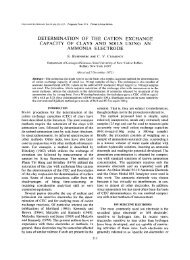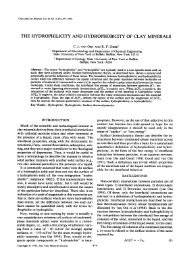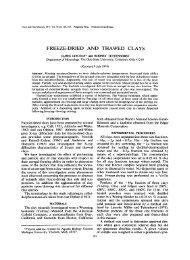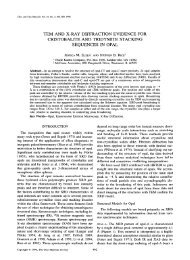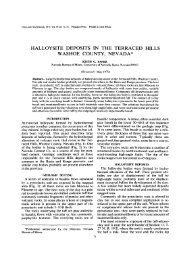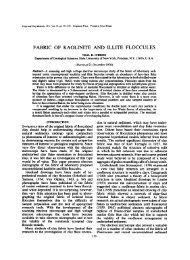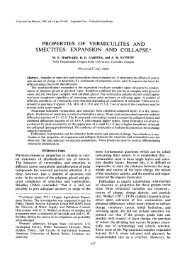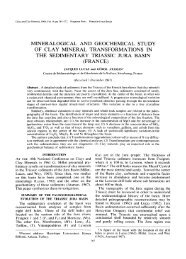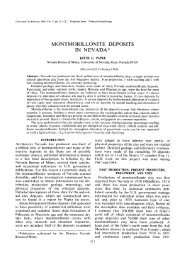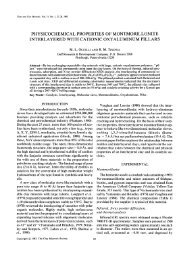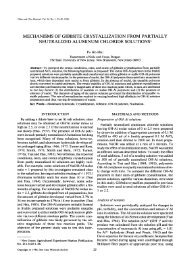formation of halloysite from feldspar: low temperature, artificial ...
formation of halloysite from feldspar: low temperature, artificial ...
formation of halloysite from feldspar: low temperature, artificial ...
Create successful ePaper yourself
Turn your PDF publications into a flip-book with our unique Google optimized e-Paper software.
FORMATION OF HALLOYSITE FROM FELDSPAR 17<br />
Table 3. Typical chemical analyses for <strong>feldspar</strong>s used for<br />
this <strong>artificial</strong> weathering study<br />
K-<strong>feldspar</strong> (microcline) <strong>from</strong> mine at Casper Mt., Casper,<br />
Wyoming. Chemical analysis obtained <strong>from</strong> F. F. Miller<br />
<strong>of</strong> International Minerals and Chemical Corporation,<br />
Custer, South Dakota.<br />
SIO 2 64.4%<br />
A1203 19.6<br />
Fe203 0.04<br />
CaO 0.1<br />
Na~O 3.0<br />
KzO 12-6<br />
Ign. 0.2<br />
99-94%<br />
Plagioclase <strong>feldspar</strong> (An7o) <strong>from</strong> anorthosite outcrop<br />
along shore at Silver Bay, Minnesota, SEI/4 NE1/4<br />
sec. 6, T. 55 N., R. 7 W. Sample number M-3190.<br />
SiOz 47.25%<br />
A1203 31 "56<br />
FeO 2.29<br />
CaO 15-39<br />
Na20 2.52<br />
K20 0-37<br />
MgO 0.27<br />
H20+]<br />
H20-~ 0.40<br />
100-05%<br />
Table 4. Localities <strong>of</strong> naturally weathered K-<strong>feldspar</strong><br />
samples<br />
DW B - 1<br />
DWB-3<br />
Orthoclase <strong>from</strong> syenite; surface <strong>of</strong> crystals<br />
weathered to depth <strong>of</strong> 1-2 mm; Mesozoic in<br />
age; roadcut in fresh syenite 1/4 mile SW <strong>of</strong><br />
Wong Nai Chung Gap along Deep Water<br />
Bay Road, Hong Kong Island, Hong Kong,<br />
B.C.C., 114 ~ 10' 20" E., 22 ~ 15' 30" N.<br />
Orthoclase <strong>from</strong> Hong Kong granite, partially<br />
weathered, slightly bleached, dull pale<br />
pink color; Upper Jurassic in age. Same<br />
locality as DWB-I.<br />
the leaching experiment. A small portion <strong>of</strong> the<br />
milky liquid was removed <strong>from</strong> the plagioclase<br />
<strong>feldspar</strong> distilling flask after 119 days, dried and<br />
X-rayed. The material was amorphous to X-ray.<br />
A rust-red discoloration appeared after 29 days<br />
on the (100) cleavage surface <strong>of</strong> the K-<strong>feldspar</strong><br />
fragments in the uppermost zone <strong>of</strong> the chamber,<br />
i.e. the most well drained and aerated part <strong>of</strong> the<br />
leaching column. Electron microprobe analysis<br />
showed that the discoloration was caused by a very<br />
small amount <strong>of</strong> iron on those surfaces. It seems<br />
that during the <strong>artificial</strong> weathering sufficient iron<br />
was able to migrate to the (100) cleavage surface<br />
<strong>of</strong> this K-<strong>feldspar</strong> to produce visible iron oxide<br />
stain, and that the staining <strong>of</strong> only one surface<br />
resulted <strong>from</strong> a differential rate <strong>of</strong> weathering with<br />
respect to the major cleavage surfaces. A white<br />
alteration product formed on the (001) and (010)<br />
cleavage surfaces but no iron oxide stain appeared<br />
here.<br />
Surface alteration on the plagioclase <strong>feldspar</strong><br />
was observed as a pale pink discoloration after<br />
112 days <strong>of</strong> leaching. The pink alteration product<br />
was not restricted to a specific cleavage surface,<br />
as was the case for the K-<strong>feldspar</strong>, but instead<br />
seemed to form as coatings at random sites on all<br />
surfaces.<br />
Electron micrographs in Figs. 3 through 7B display<br />
the most commonly observed forms <strong>of</strong> surface<br />
alteration products formed on naturally and<br />
<strong>artificial</strong>ly weathered K-<strong>feldspar</strong>s. Figures 3A and<br />
3 B show the first stage in the natural and <strong>artificial</strong><br />
weathering <strong>of</strong> K-<strong>feldspar</strong>. The first alteration product<br />
to form on the mineral's surface appears as<br />
lines <strong>of</strong> tiny bumps, as small as 0.01 tz in diameter.<br />
This initial product and all those described subsequently<br />
form at a variety <strong>of</strong> sites on <strong>feldspar</strong><br />
surfaces. Formation <strong>of</strong> these products may take<br />
place along apparent crystal dislocations (Fig. 3A),<br />
at the intersection <strong>of</strong> cleavage planes, along etch<br />
pits, on any irregularity on the mineral's surface,<br />
and at apparently random sites on flat surfaces.<br />
The morphology <strong>of</strong> the alteration products is the<br />
same on all <strong>feldspar</strong> surfaces examined. The tiny<br />
bumps grow outward <strong>from</strong> the <strong>feldspar</strong> surface to<br />
form tapered projections (Fig. 3A) which may<br />
attain a micron in length. It is not evident in most<br />
instances whether the tapered projections are<br />
hol<strong>low</strong> or solid, though it seems that many are<br />
hol<strong>low</strong>. Figure 4B shows hol<strong>low</strong> tubes rising<br />
upward <strong>from</strong> the <strong>artificial</strong>ly weathered K-<strong>feldspar</strong><br />
<strong>from</strong> bases that outline etch pits. Lengthening <strong>of</strong><br />
the tubes is <strong>of</strong>ten accompanied by a tendency for<br />
them to tilt and overlap one another (Figs. 4A<br />
and 4B).<br />
As the tapered projections continue to grow,<br />
they develop wide bases that are more sheet-like<br />
than tube-like in form (Figs. 5A and 5B). As the<br />
bases widen they coalesce to form a continuous<br />
flame-shaped film or sheet (Figs. 6A and 6B).<br />
Segments <strong>of</strong> the flame-shaped sheet may roll to<br />
form tubes that are inclined at a high angle to the<br />
<strong>feldspar</strong> surface (Fig. 5B, arrows). Thus it appears<br />
that the form <strong>of</strong> the alteration product may be either<br />
as rolled tubes (Fig. 5B, arrows) or as non-rolled<br />
hol<strong>low</strong> tubes (Fig. 4B).<br />
Figure 7A shows a bundle <strong>of</strong> <strong>halloysite</strong> tubes



